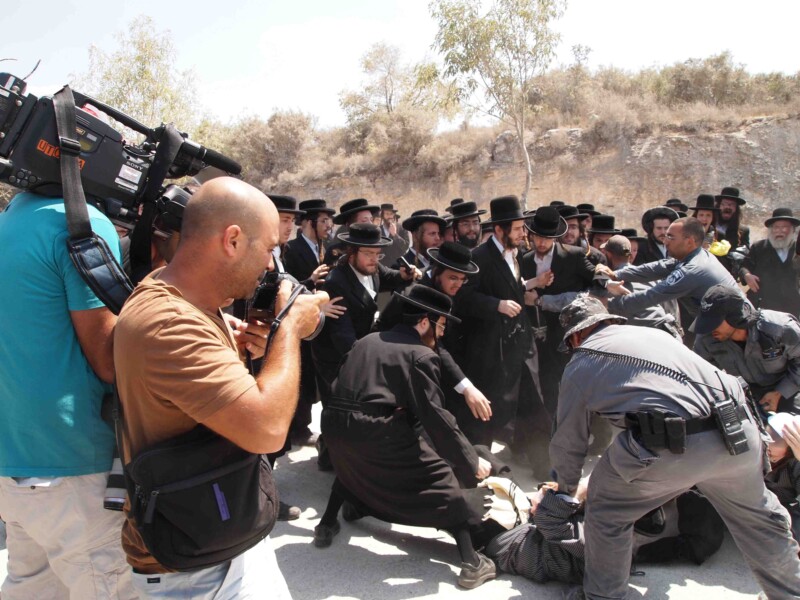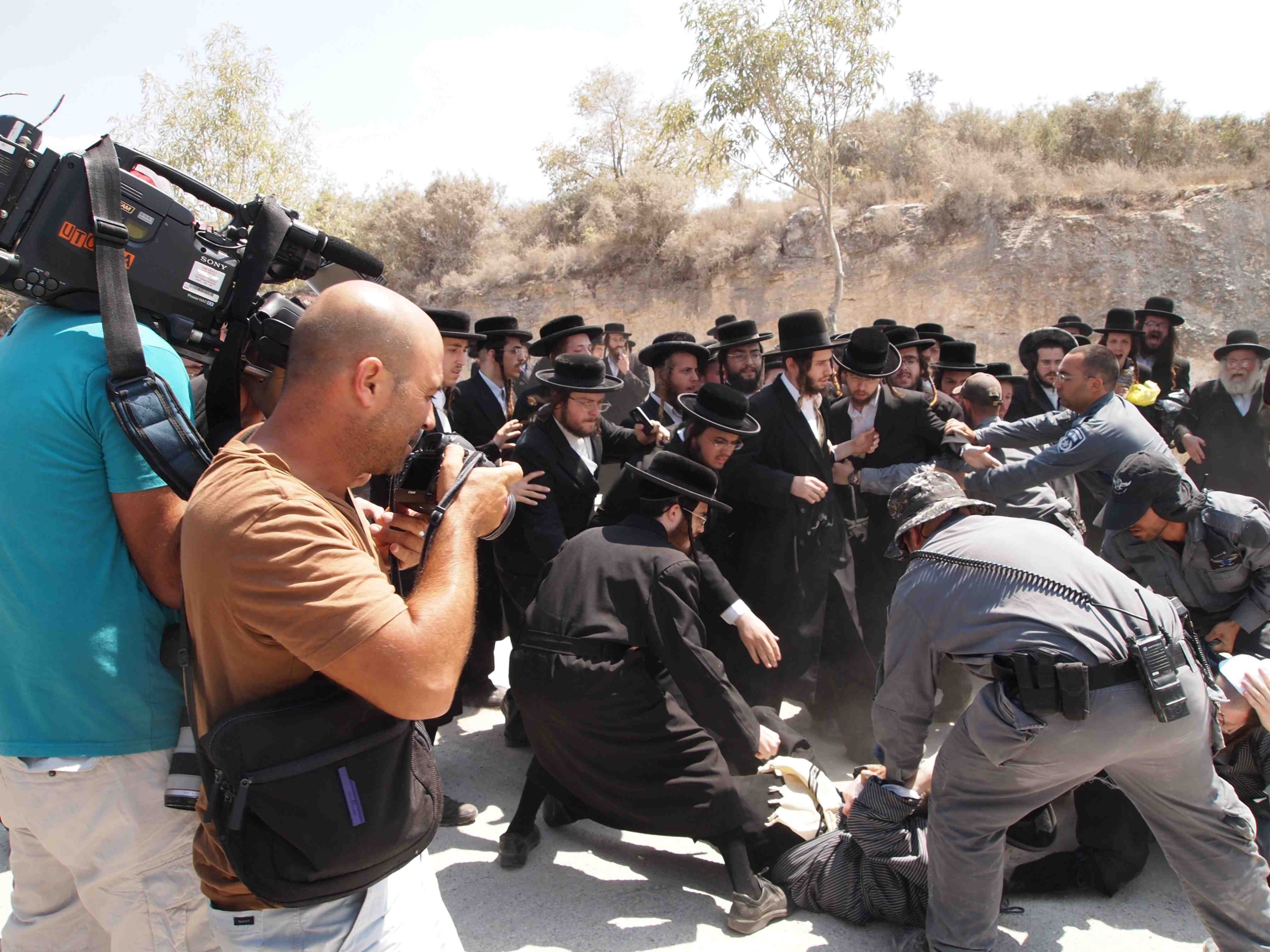When Donald Trump descended his golden escalator one fateful morning in June 2015, I had no idea how much it would affect my social and professional life, more than 9,000 kilometers away. I had grown up in New York but was living in Beit Shemesh, an American enclave between Jerusalem and Tel Aviv, covering international Jewish communities for The Jerusalem Post. I was the only reporter many of my neighbors knew—and their only outlet for intense distrust in the media.
Before I knew it, my little American enclave in the Middle East became an outpost of Trump country. The sexton of my synagogue began wearing a MAGA hat, and longtime friends began parroting Trump’s anti-press talking points. They were already suspicious of the Israeli press, fed a steady diet of anti-media attacks by Prime Minister Benjamin Netanyahu. By early 2016, Joe Federman, the Associated Press’s Jerusalem bureau chief, had begun to characterize the government’s condemnations as “incitement against the foreign media.”
ICYMI: Eleven newsletters to subscribe to if you work in media
“It has become very unpleasant being a journalist in this country,” Federman told a crowd of American Jewish leaders visiting Jerusalem. “Not only do politicians accuse us of being hostile, we are accused of staging events for the media.” The government’s hostility was shared by many citizens. According to a 2017 survey by the Israeli Democracy Institute, a Jerusalem NGO, only 30 percent of Jewish Israelis expressed confidence in the media as an institution.
Since the beginning of the Trump era, I have been repeatedly accosted by friends and acquaintances seeking to vent about the Fourth Estate’s perceived iniquities. I have been forced to endure lectures on media “corruption” and discourses on the superiority of Fox News to the “liberal” outfits. I’ve sat through condescending conversations about the lack of credibility of outfits reporting on Assad’s chemical weapons. I’ve been told repeatedly (including by close relatives) that I’m okay, but I’m not representative of the press corps. I have been told that I “don’t really understand how the media works.” I was once even informed, with great solemnity, that the role of newspapers is to “advance [President Trump’s] agenda.”
And I have learned that producing quality journalism isn’t enough when readers understand neither how news is gathered nor why an independent press is crucial to a free society.
Before I knew it, my little American enclave in the Middle East became an outpost of Trump country. The sexton of my synagogue began wearing a MAGA hat
In religious communities, the press is seen by many as an institution meant to uphold social norms, rather than stir the pot. Four years before Trump’s campaign, in late 2011, religious extremists declared war on “immodesty” in Beit Shemesh. New communities of ultra-Orthodox Jews and Americans were sprouting up side by side in the city—including residents from more extreme ultra-Orthodox sects, many of whom held conservative views on female modesty.
By December of that year, the battle had become a matter of international interest, due to the fight over Orot Banot, an Orthodox girls school on the border between an American neighborhood and an ultra-Orthodox (known in Hebrew as Haredi) community.

Israeli reporters film violent clashes between ultra-orthodox rioters and police in Beit Shemesh. Credit: Sam Sokol.
As tensions rose, the Haredim began holding daily vigils outside the school. They spat on young girls and called them “sluts,” “whores,” and worse. One student, 8-year-old Naama Margolese, quickly became the face of the conflict after her vivid description of being spat on by protesters was aired on Israeli television. The conflict spread beyond the school, and residents soon found themselves battling for the right to walk the city’s streets. Female joggers and motorists passing through Haredi neighborhoods were harassed (and sometimes violently accosted), and members of the city’s self-appointed modesty patrol took to public transportation in an attempt to enforce de facto gender segregation on buses.
At the time, I was a features writer for the Post and a resident of the more religiously moderate neighborhood of Ramat Beit Shemesh Aleph. While the Post’s Jeremy Sharon covered the religion beat for our daily edition, my editor at the weekend magazine commissioned a series of longform reports delving into the root causes of the conflict.
The same kind of intolerance that the extremists leveled against these young, Americanized girls was now leveled against me, a journalist trying to tell a story that some would rather have suppressed.
Every week, people would approach me to hash out my articles, praising or criticizing my coverage according to their personal outlook. Many of my friends were sympathetic, but their disapproval was keenly felt. Those who sympathized with the Haredi community, even if they did not agree with the use of violence, accused me of peddling lashon hara (Biblically prohibited gossip) and of creating a chillul Hashem (desecration of God’s name), both serious matters for Orthodox Jews. I was socially stigmatized among my religiously conservative neighbors.
Sometimes this took ugly forms. I reported on a moderate, local rabbi who had penned a lengthy public letter decrying the “overreaction” to the assault on Naama Margolese and refusing to condemn her attackers. To do so, he asserted, would be to fall into the media’s trap and cause his community to be associated in the public’s mind with the “kooks.” After my reporting was published, one resident of my neighborhood went so far as to threaten my family. A neighbor confronted me once when I was at lunch with friends, asking why I felt I had the right to publish the rabbi’s words without his permission. Unsatisfied with my answer, he kicked me out as my friends watched, silently and impassively.
For the most part, Haredi print outlets are subservient to the community’s rabbinic leadership and have become ever more stringent in restricting the publication of images of women. There are few ultra-Orthodox people in Israel’s mainstream press, and while recent years have have seen the establishment of several independent Haredi news websites, many rabbis are still vocally opposed to internet usage, in large part because it is a source of unregulated information. As such, I found myself compelled to justify my work on numerous occasions, including a confrontations with an ultra-Orthodox journalist who questioned which rabbis had given me “permission” to report certain facts.
Raised on the idea that protecting the community’s image is of paramount importance, the Haredim strongly disagree with the “sunlight is the best disinfectant” weltanschauung to which we in the press adhere. As Dr. Yoel Finkelman, author of Strictly Kosher Reading, put it, in the ultra-Orthodox community, “the role of the press should not be to shed light on problems, but to support our existing worldview and self-perception.”
For a long time I pushed back against this idea in an attempt to become a local evangelist for the media, explaining how the sausage is made and trying to remove the misconceptions about our line of work. It hasn’t worked. And while many of my colleagues in Israel have had different experiences, I know I’m not alone.
“It is an ongoing challenge when you are permanently embedded in your community to report on it in a deep, meaningful, and accurate way, because you face many pressures from everybody up to and including your spouse,” says Alan Abbey, a veteran Israeli journalist and adjunct professor of journalism at National University of San Diego. “And it’s the same in all ethnic and minority media. People in the gay media or people in the Hispanic media face similar issues….Ethnic and minority journalists are permanently embedded in their communities, and it’s very difficult to break out of that box.”
We have lost a lot of ground in recent years, and I’ve become convinced that much of the antipathy toward the media stems from basic misapprehensions regarding the nature and role of the press. Only a strong and sustained push for media literacy will allow us to regain the trust of a public that has, in some ways, become fundamentally hostile to our mission. The Haredi community may be an extreme example of this phenomenon, but in an age of increasing fragmentation and tribalism, it is no longer the outlier it once was.
Just as in the Haredi community, many news consumers in the United States now perceive media outlets as partisan if they don’t reinforce their biases. They, unfortunately, see the role of the press as supporting specific agendas and ideologies. This kind of thinking is dangerous and must be countered if we are to continue to do our jobs as the watchdogs of democracy.
ICYMI: Voices on the left are rising in the US. Why aren’t they in mainstream media?
Sam Sokol is a freelance journalist based in Israel. Most recently a correspondent with the Israel Broadcasting Authority (IBA), he was previously an international and Jewish affairs correspondent for The Jerusalem Post. He is currently writing a book on anti-Semitism, propaganda and national memory formation in post-Maidan Ukraine.

